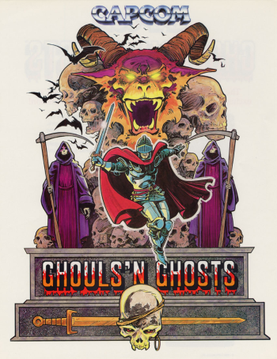
Ghouls 'n Ghosts, known as Dai Makaimura in Japan, is a side-scrolling platform game developed by Capcom, released as an arcade video game in 1988 and ported to home platforms. It is the sequel to Ghosts 'n Goblins and the second game in the Ghosts 'n Goblins series.

Lethal Xcess, also known as Lethal Xcess: Wings of Death II or just Wings of Death II, is a shoot 'em up game developed by two members of demo crew X-Troll and published by Eclipse Software in 1991 for the Atari ST and Amiga. It is a sequel to 1990's Wings of Death, in which its wizard hero goes into the far future to fight the descendants of the evil witch that he had defeated in the first game. Despite having been acclaimed by critics, the game was a commercial failure.

Aero Fighters, known as Sonic Wings in Japan, is a vertically scrolling shooter originally released in arcades in 1992 by Video System and was ported to the Super Nintendo Entertainment System in 1993. It was the first in the Aero Fighters series, and a spiritual successor to the 1991 Turbo Force.

Commando, released as Senjō no Ōkami in Japan, is a vertically scrolling run and gun video game released by Capcom for arcades in 1985. The game was designed by Tokuro Fujiwara. It was distributed in North America by Data East, and in Europe by several companies including Capcom, Deith Leisure and Sega, S.A. SONIC. Versions were released for various home computers and video game consoles. It is unrelated to the 1985 film of the same name, which was released six months after the game.
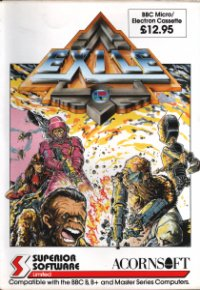
Exile is a single-player action-adventure video game originally published for the BBC Micro and Acorn Electron in 1988 by Superior Software and later ported to the Commodore 64, Amiga, CD32 and Atari ST, all published by Audiogenic. The game was designed and programmed by Peter Irvin and Jeremy Smith. It is often cited as one of the earliest examples of a Metroidvania game and featured "realistic gravity, inertia and object mass years before players understood the concept of a physics engine... an astounding level of AI, stealth-based gameplay, a logical ecosystem governing the world's creatures and a teleportation mechanic that feels startlingly like a predecessor to Portal".
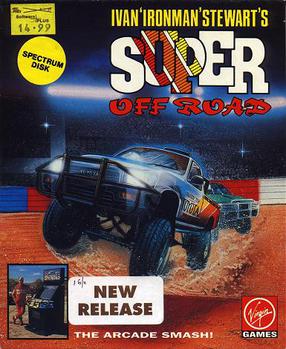
Ivan "Ironman" Stewart's Super Off Road is an arcade video game released in 1989 by Leland Corporation. The game was designed and managed by John Morgan who was also lead programmer, and endorsed by professional off-road racer Ivan Stewart. Virgin Games produced several home versions in 1990. In 1991, a home console version for the Nintendo Entertainment System was later released by Leland's Tradewest subsidiary, followed by versions for most major home formats including the Master System, Genesis, Super NES, Amiga, and MS-DOS. A port for the Atari Jaguar was announced but never released. Some of the ports removed Ivan Stewart's name from the title due to licensing issues and are known simply as Super Off Road.

Xenon 2: Megablast is a 1989 shoot 'em up video game developed by The Bitmap Brothers and published by Image Works for the Amiga and Atari ST. It was later converted to the Master System, PC-98, X68000, Mega Drive, Commodore CDTV, Game Boy, Acorn Archimedes and Atari Jaguar platforms. The game is a sequel to Xenon and takes place a millennium after the previous title. The goal of the game is to destroy a series of bombs planted throughout history by the Xenites, the vengeful antagonists of the first game.
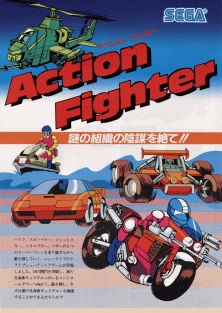
Action Fighter is an overhead vehicular combat game released by Sega for arcades in 1986. It was ported to the Master System the same year, and then to the Amiga, Amstrad CPC, Atari ST, Commodore 64, ZX Spectrum and IBM PC compatible computers.

Hostages is a 1988 tactical shooter video game developed and published by Infogrames for the Acorn Electron, Archimedes, Atari ST, Amiga, Apple IIGS, Amstrad CPC, BBC Micro, Commodore 64, MS-DOS, MSX, Nintendo Entertainment System, and ZX Spectrum. The game depicts a terrorist attack and hostage crisis at an embassy in Paris, with the player controlling a six-man GIGN counterterrorist team as they are deployed to defeat the terrorists and free their hostages.

Silkworm is a horizontally scrolling shooter developed by Tecmo and first released for arcades in 1988. In 1989 it was ported to the Amiga, Atari ST, Commodore 64, ZX Spectrum, Amstrad CPC and NES (1990) systems by The Sales Curve and released by Virgin Mastertronic.

Captain Dynamo is a vertically scrolling platform game developed by Codemasters and released in 1992. Captain Dynamo, an aging superhero, is brought out of retirement to recover a haul of stolen diamonds from the trap-infested rocket-ship of the villainous Austen Von Flyswatter. It was published for the Amiga, Atari ST, Commodore 64, ZX Spectrum, Amstrad CPC, and MS-DOS. Versions for Game Gear and Mega Drive were planned but never released.

SWIV is a vertically scrolling shooter released in 1991 for the Amiga, Atari ST, Commodore 64, MSX, ZX Spectrum, and Amstrad CPC computers. A Game Boy Color conversion was published in 2001.

Star Parodier is a vertical-scrolling shoot 'em up video game developed by Kaneko and published by Hudson Soft for the PC Engine CD-ROM² in 1992. It is a spin-off of the Star Soldier series and was localized for North America as Fantasy Star Soldier, but this version was never released. The game was released for the Wii Virtual Console on March 7, 2008 in Japan, March 16 in Europe and later in North America on August 11. The title is also playable on the Turbografx-16/PC Engine Mini Console.

Space Gun is a 1990 first-person shooter arcade game released by Taito. The game is set aboard a crippled space station that has been overrun by hostile alien creatures. The objective is to rescue human crew members while destroying the alien creatures. The game lets the player shoot limbs off the creatures, resulting in blood splatters.
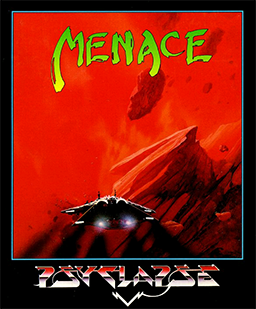
Menace is a horizontally scrolling shooter developed by DMA Design and published by Psygnosis. It was originally released for the Amiga in 1988, and was ported for the Atari ST, Commodore 64, and MS-DOS in 1989. The game is set on the planet of Draconia, where players are tasked with destroying the planet's defence mechanisms in order to kill the harmful creatures.

Beyond the Ice Palace is a platform game published by Elite Systems in 1988 for the Amiga, Amstrad CPC, Atari ST, Commodore 64, and ZX Spectrum.

HeroQuest is a video game based on the HeroQuest board game.
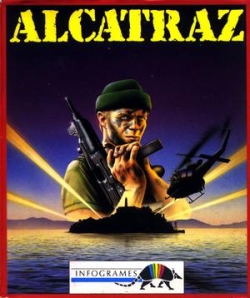
Alcatraz is a shooter game created by 221B Software Developments and published by Infogrames. It was released for MS-DOS, Atari ST and Amiga in 1992, as a spiritual sequel to Infogrames' 1988 game Hostages.

The Real Ghostbusters is a 1987 shoot 'em up arcade game developed and published by Data East. It is loosely based on Ghostbusters. In Japan, Data East released it as a non-Ghostbusters arcade game under the title Meikyuu Hunter G. In 1989, Activision published The Real Ghostbusters for Amiga, Amstrad CPC, Atari ST, Commodore 64, and ZX Spectrum.

Goldrunner is a vertically scrolling shooter developed by Steve Bak and Pete Lyon for the Atari ST and published by Microdeal in 1987. Rob Hubbard composed the music. An Amiga version followed, as well as a 1988 sequel, Goldrunner II.




















